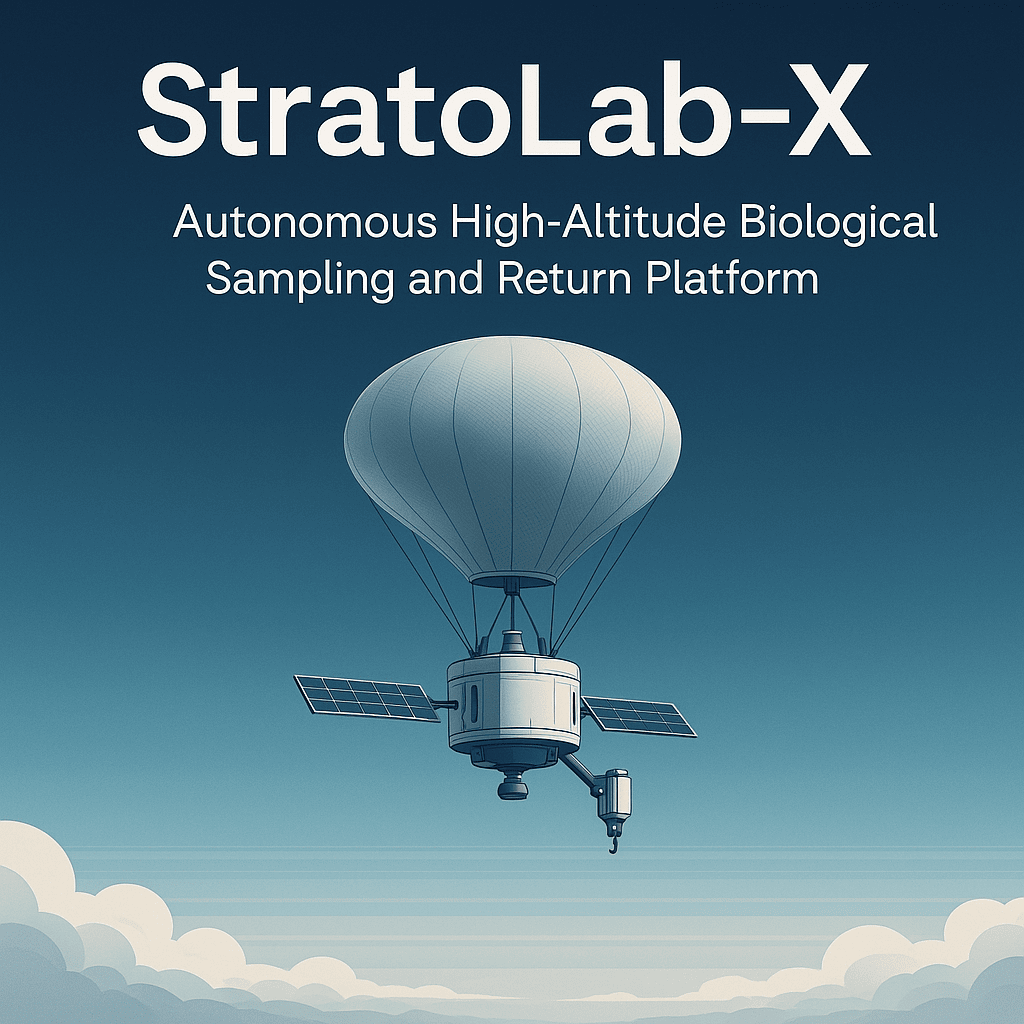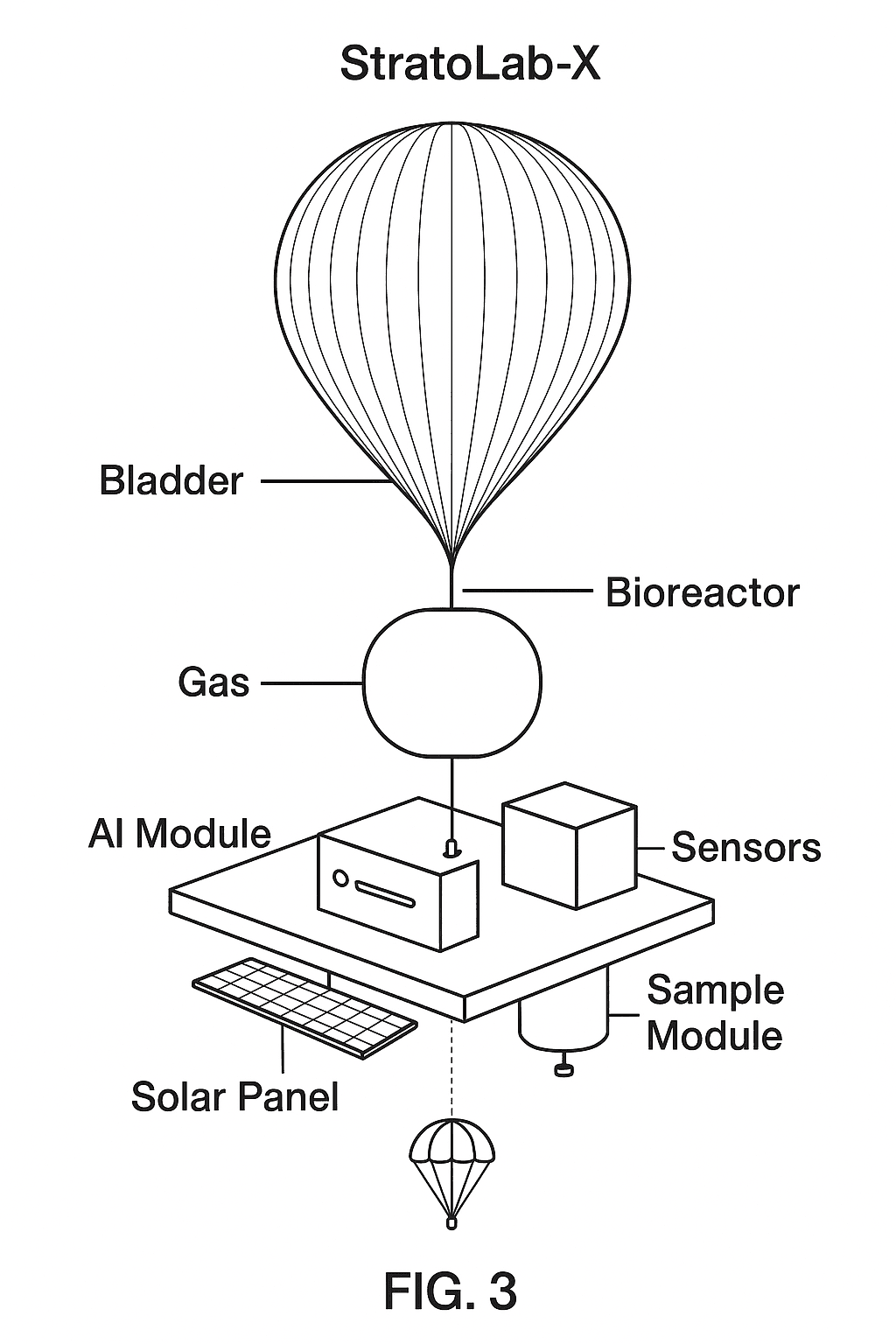StratoLab-X: Autonomous High-Altitude Biological Sampling and Return Platform
Patent Pending
GreyArray Skunk Works | Published:
Introduction: The Edge of the Known Sky
 StratoLab-X is more than a scientific instrument—it’s a declaration. A declaration that the upper atmosphere of Earth, often dismissed as an inhospitable void between ground and space, is in fact a vibrant, living boundary layered with mystery, ancient biology, and data from the very edge of habitability. Designed as part of the GreyArray Skunk Works, StratoLab-X exists to pierce that veil. This autonomous high-altitude biological sampling and return platform was built with one central goal: to systematically explore, catalog, and return biological and environmental data from the rarely sampled upper layers of the atmosphere, including the stratosphere, mesosphere, and, in edge cases, the thermosphere.
StratoLab-X is more than a scientific instrument—it’s a declaration. A declaration that the upper atmosphere of Earth, often dismissed as an inhospitable void between ground and space, is in fact a vibrant, living boundary layered with mystery, ancient biology, and data from the very edge of habitability. Designed as part of the GreyArray Skunk Works, StratoLab-X exists to pierce that veil. This autonomous high-altitude biological sampling and return platform was built with one central goal: to systematically explore, catalog, and return biological and environmental data from the rarely sampled upper layers of the atmosphere, including the stratosphere, mesosphere, and, in edge cases, the thermosphere.
This zone—ranging from 10 km to over 100 km above sea level—is home to a sparse yet highly compelling array of lifeforms and organic signatures, from bacterial spores to viral fragments to ancient seeds and unknown particles that defy classification. Many of these entities exist in a suspended state for decades, centuries, or longer—unexposed to UV sterilization due to cloud layering or chemical shielding, and potentially undisturbed since before human civilization even began. These are the skyborne fossils of a living, floating archive. StratoLab-X was designed to reach them, return them, and preserve them in what we’ve named the Skyborne Library—a continuously expanding, openly documented archive of high-atmosphere biology and conditions.
Platform Vision: A Scientific Drone with an Ancient Mission
The vision behind StratoLab-X is to treat the high atmosphere not just as a transitional zone but as a domain—a legitimate environment of study in its own right. Historically, we’ve peered into it with weather balloons and occasionally collected particles by accident. But StratoLab-X reverses the equation. This is not a weather balloon with a sensor—it is a mission-specific biological sampling lab that happens to float. It is designed for multi-month missions, complete autonomy, and modular, intelligent return mechanisms that allow it to deliver specific payloads without sacrificing platform longevity.
Where others see dust, we see DNA. Where others see UV exposure and cold voids, we see evolution’s outermost reach. StratoLab-X is designed to embrace that perspective in every detail, from its hydrogen-replenishing lift system to its blockchain-sealed sample metadata, to its real-time adaptive sampling intelligence that tracks particle densities and navigates toward zones of peak biological density.
Design and Lift: A Living System That Floats
At its core, StratoLab-X is a symbiotic blend of biology and engineering. Its lift is provided not just by helium or hydrogen alone but by a regenerative bioreactor system onboard the platform itself. This system uses Cyanothece—a genus of nitrogen-fixing cyanobacteria that photosynthesizes during the day and produces hydrogen as a byproduct of nitrogen fixation during its dark cycle. By tightly controlling the day/night rhythms, isolating oxygen during gas production, and regulating gas collection chambers, the platform is able to generate hydrogen gas in situ.
This process allows it to extend flight duration indefinitely, limited primarily by the health of the bioreactor, power constraints, or catastrophic failure. The platform itself is a hardened composite of lightweight aerogel insulation, UV-resistant transparent materials, and adaptive shielding that regulates internal temperatures despite the brutal environmental extremes of the stratosphere—where temperatures can fall below -60°C and UV radiation exceeds surface levels by an order of magnitude.
The Sampling Array: Hybrid Gel, Membrane, and Static Collection
At the heart of its scientific mission is a tri-modal sampling array, designed to capture as many types of airborne particles as possible while minimizing contamination and preserving sample fidelity. The system includes gel-based particle traps, electrostatic membrane collectors, and atmospheric filtration cyclers, each optimized for different particle sizes, charges, and fragility. Samples are sealed in sterile chambers onboard, tagged with multidimensional metadata, and preserved for return.
The Modular Return System: Precision Descent Without Platform Loss
 One of the greatest design breakthroughs in StratoLab-X is its autonomous return system. Rather than requiring the full platform to descend in order to retrieve collected samples—risking platform loss or interruption—StratoLab-X instead deploys modular return capsules. Each is a self-contained, soft-reentry pod equipped with an insulated container, mini parachute, and GPS+radio beacon. This allows the platform to continue flight uninterrupted, enabling multiple returns over its full operational lifecycle and allowing time-staggered biological studies across seasons.
One of the greatest design breakthroughs in StratoLab-X is its autonomous return system. Rather than requiring the full platform to descend in order to retrieve collected samples—risking platform loss or interruption—StratoLab-X instead deploys modular return capsules. Each is a self-contained, soft-reentry pod equipped with an insulated container, mini parachute, and GPS+radio beacon. This allows the platform to continue flight uninterrupted, enabling multiple returns over its full operational lifecycle and allowing time-staggered biological studies across seasons.
Autonomous Intelligence and Adaptive Navigation
StratoLab-X is not controlled from the ground. It is taught before launch and thinks during flight. Aboard the platform is a resilient low-power AI system designed to monitor and react to dozens of variables per second. It manages altitude, particle detection, lift regulation, power balancing, and dynamic navigation based on real-time biotic signals. It behaves like a living organism in the sky—tilting and adjusting toward zones of atmospheric intrigue.
The Skyborne Library: Humanity’s Upper-Atmosphere Archive
Samples returned by StratoLab-X are added to the Skyborne Library, a living archive of high-altitude biosignatures. Designed as part scientific repository, part planetary record, and part poetic tribute, the Library grows with each flight. It becomes a long-term memory system for the upper atmosphere—documenting what we find and preserving it for the future of Earth-bound and spacefaring biology alike.
Applications Beyond Science
Though scientific in origin, StratoLab-X holds future potential in commercial and planetary applications: bio-seeding, precision agriculture, environmental forensics, ultra-high-speed sample return, and even as atmospheric infrastructure for orbiting platforms or disaster detection networks. It is, in essence, a new class of device: a sky-dwelling platform with purpose, personality, and precision.
Conclusion: A New Layer of Understanding
StratoLab-X is a window to the living sky. It is a precise, delicate hand reaching into the heavens to touch and retrieve lifeforms that float unseen. By making the upper atmosphere accessible, measurable, and returnable, we invite the scientific community—and all of humanity—to reconsider our relationship with this forgotten ocean of air and light.
This is not just engineering. It is reverence turned into action. It is technology serving awe. StratoLab-X is our step into a realm where the sky is no longer the limit—but the archive.